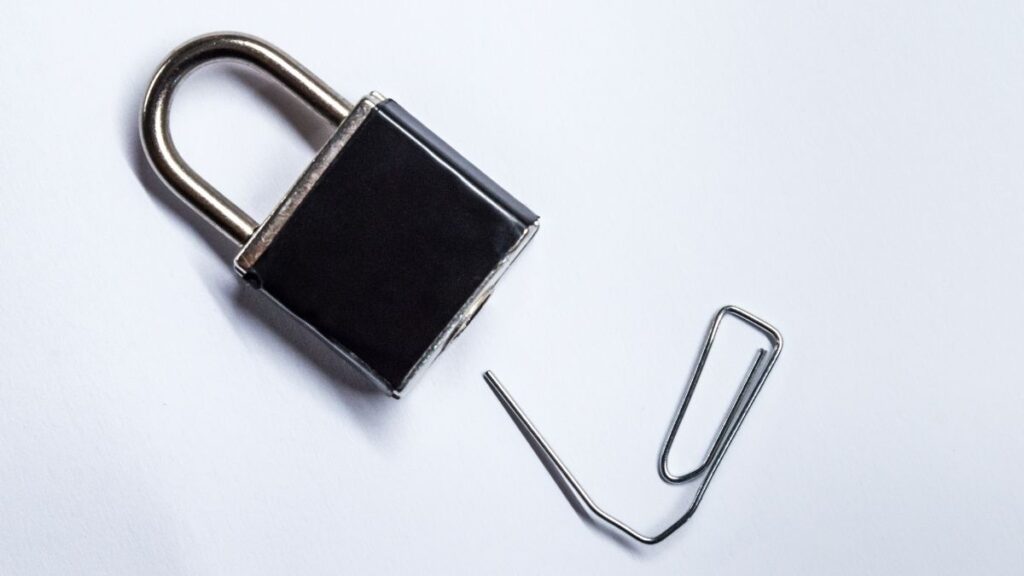
Picture this: you get home from a long day at work – only to find that your house key has fallen off your keyring. Your phone is dead; you have no way of calling for help. There’s nobody coming to help you. Now you wonder, “Can I pick a lock with a paperclip?”
As you rummage through your vehicle to see if there is anything that can help you find a pair of paperclips you start feeling like MacGuyver.
Is it possible to fashion a paperclip lock pick? Sure is. However, there are a few things you need to know first if you’re going to be successful in your efforts here.
If you haven’t done so already, it would be helpful to know how a lock and padlock function. This way you’ll know what you’re dealing with.
Step 1: You Need Two Tools to Make Your Lock Pick
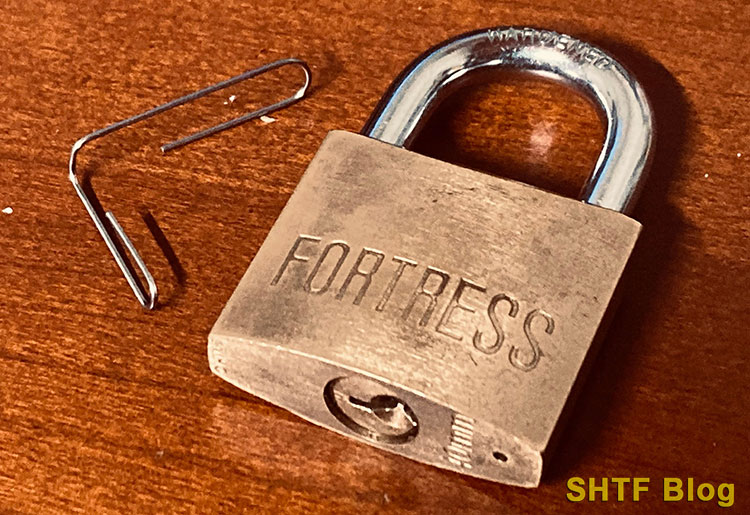
A single paperclip is unlikely to be enough. If you’re picking a lock, you need two tools: a lockpick and a turning (or tension) tool. In this instance, the paperclip is substituting itself for a lockpick. That still means that you will need a turning tool, however. A professional tension tool is simply a flat piece of metal. If you can find something which will replicate that you’ll likely be set.
In the past, I’ve used a small flathead screwdriver to substitute as a turning tool; however, if one of these is not available you may be able to achieve success by using another paperclip to add tension to the lock. To create my turning tool out of a second paperclip, I would try to fashion a rough ‘L’ shape out of the material.
Step 2: Construct your Lockpick Paperclips
To begin with, you’ll need to unfurl one of the paperclips with a long straight leg. You’ll be putting a bit of downwards pressure on this leg so the sturdier of the two paperclips might be a better candidate for this mission.
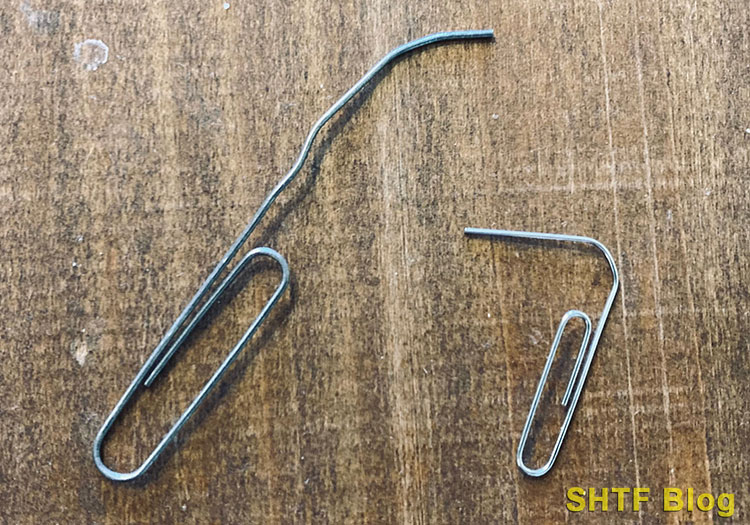
You’re going to want to straighten the paperclip enough that you can stick a key length of the leg into the key slot on the lock. You’re also going to need a small bend at the end of the paperclip so that it is akin to a ‘hook’ lockpick. It’s this tiny hook that you’ll be using to push the lock pins (however many there are) down into their chambers. Once all the pins are pushed out of the way, the lock cylinder can turn and (hopefully!) disengage the lock.
Step 3: Position Both Tools Within the Lock
To start, you’re going to insert one end of the hook tool into the lock’s key slot and then push with the appropriate amount of tension. What that “appropriate amount of tension” actually is will depend upon the type of lock, but if you have prior experience with lockpicking you’ll understand what this is automatically.

Remember, the tension tool is being pulled on to apply pressure to the bottom of the keyway while the hook tool is being used to press against the pins and push them down. Prior lockpicking experience will help you to mentally picture this, and I highly recommend practicing this skill before you need to resort to using paperclips to try to gain access to a lock.
Keep in mind that one of the main reasons that people have difficulty with lock picking is either putting too much or too little tension on the lock cylinder. Like Goldilocks, you must find what’s just right. Put slight sideways pressure on the tension tool as you start searching for the pins.
Step 4: Use the Hook to Press the Pins
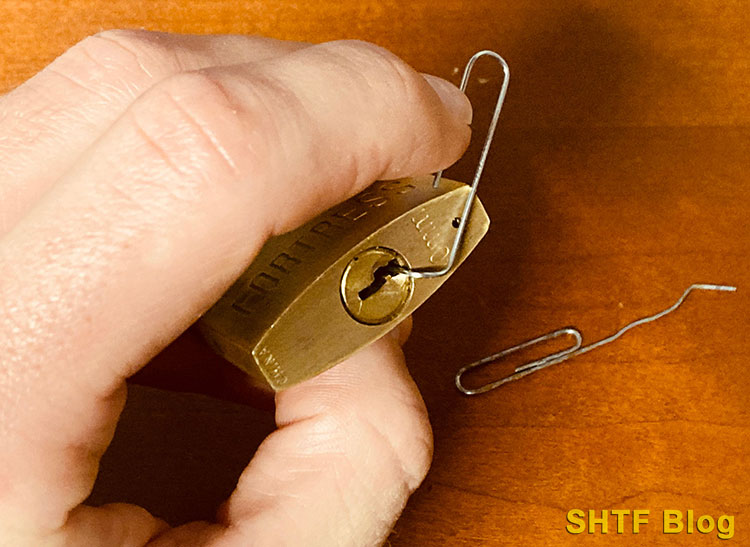
You’re going to go chamber by chamber testing the pins within to see if you can get them to move until you feel a slight click. Feeling this will help you to know that you’ve got the pin nestled right where it needs to be so that it doesn’t get bound up in the shear line.
Oftentimes you will have to skip around from pin chamber to pin chamber when you’re picking. It makes no difference with a paperclip. If a lock has five chambers (many common locks do) and I’m picking 1-4-3-2-5 to get it open with a lockpick, I do the same with a paperclip.
In other words, sometimes (and you could use any chamber for example here) chamber 1 picks fine. But when I move to chamber 2, it won’t budge. I skip it and go to chamber 3, which picks just fine. Chamber 4 won’t budge, and neither will chamber 5. I go back to 2. It picks great. Then I hit 4, and it picks great. Then 5.
If you have proper tension in the correct direction when the last pin is pushed down, the cylinder should turn.
And voila, the lock is opened.
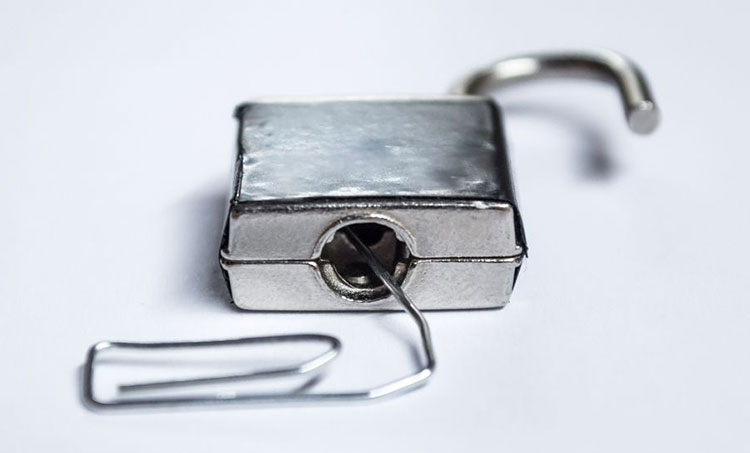
Locks are like that. You always target the path of least resistance. Didn’t Sun Tzu say something about that? You follow the same goals with a lock.
And remember as well that you are holding a simple hook in your hands, not a more specialized rake tool. If you can fashion a rake out of a paperclip for scrubbing motions, go for it. I just highly doubt you’ll have the resources necessary to make a rake out of a paperclip if you’re in such dire straits that you’re using a paperclip to begin with.
Keep in mind that this can be an incredibly difficult skill to master. Paperclips have nowhere near the resiliency of an actual lockpick and I had more trouble getting the paperclip to remain straight then anything else. It kept wanting to bend.
Lockpicking isn’t an inherently easy activity either.
As a locksmith, there are still times where I’m not able to get a door picked open and have to resort to the drill. Whether dirt and twigs are stuck inside the keyway, the pins are rusty, or you’re dealing with a lock full of mushroom pins, there are all kinds of obstacles that could throw curve balls your way here.
To boil it all down: Just don’t jump into this activity with high expectations of success – especially without prior experience.
How to Pick a Lock with a Paperclip Final Thoughts
And really, that’s all there is to it. What should be noted is that you’re going to have to be patient with this type of improvised method. While I’ve known people who have picked Medeco locks with paperclips before – a skill well beyond my ability – using a paperclip to pick anything is not an ideal circumstance.
The way a bent paperclip will fit and press in your hand will be uncomfortable and really make it feel as if you don’t really have a good handle on anything. My best advice here? Suck it up and just deal with it. Really, what else do you expect? A small paperclip isn’t going to fit in your hand as well as a proper tool designed for the specific job at hand.
Other things to consider: you may be able to pound out the end of your turning/tension tool with a rock to see if you can get a better angle to grab the keyway slot better. You may also want to consider leaving the hook of the turning tool at a sharper angle so that the pressure you’re applying to the keyway doesn’t keep causing the metal to slip out.
Before you have to stoop to such drastic measures, though, be sure to read up on the subject of lockpicking and get some pin-bumping time in beforehand to ensure you know the ins and outs of locks before you need to pop one open for real.
- Hardcover Book
- Central Intelligence Agency (Author)
- English (Publication Language)
- 64 Pages - 08/01/2011 (Publication Date) - Skyhorse (Publisher)
Lockpicking is not an exact science, and knowing what you’re getting yourself into before you jump into improvised tool lock warfare can make all the difference in the world for you when the chips are down.
If you want to get started in the world of lock picking, get yourself some practice locks and an entry level lock pick set to get your understanding of what you’re trying to do primed. Beginner’s lock picking kits are inexpensive and easily obtainable through Amazon. They universally come with a pre-made set of picks, rakes, tension tools, and some kits even offer clear plastic practice locks so you can see what you’re doing as you practice.
- Pick set Includes 90 Degree Hook, 90 Dagree Hook, Large Full Hook, Straight Pick, Small Full Hook, Combination Pick, Offset Pick, Hose Pick, Cotter Pick, double angle pick
- Heavy-duty hook and pick set has 10 shapes, suitable for any situation, and provides a drawing force specification of more than 200 pounds to complete your work excellently.
- The ergonomic handle structure and the soft rubber layer can maximize the comfort of the handle and can effectively prevent the fatigue of the hand during long-term use.
- The whole set of tools is equipped with a special tool bag, which is very convenient to store and carry.
- This pick and hook set can be conveniently used for ignition system, intake valve, rifle bolt surface, seals, fuel valve O-ring, hose end O-ring and various electronic equipment. It is your right assistant for repair or disassembly.
These items, combined with a touch of practice and maybe a bit of YouTube guidance will improve your knowledge of how a lock works before you have to resort to desperate lock pick measures.


